Russia plans to kill a quarter-million reindeer amid anthrax fears
You know Dasher and Dancer, Prancer and Vixen, Comet and Cupid . . . ?
Their cousins may all be dead soon.
Faced with a public health crisis straight from a dystopian horror movie, officials in a remote region of Siberia have proposed killing off 250,000 reindeer by Christmas to minimize the possible spread of deadly anthrax bacteria, according to the Siberian Times.
The alarm started in July, when an outbreak of the bacteria killed a 12-year-old nomadic boy and sickened nearly 100 people in the Yamalo-Nenets Autonomous Okrug, a vast northwestern region of the Siberian tundra. More than 2,300 reindeer also died.
[Previously: Anthrax sickens 13 in western Siberia. And a thawed-out reindeer corpse may be to blame.]
The region’s governor, Dmitry Kobylkin, declared a state of emergency but also tried to reassure the Nenets, the nomadic indigenous people of the region, who roam with the herds of reindeer and depend on them for their existence.
“There is no epidemic in Yamal,” Kobylkin told the Associated Press then. “Only a small area was quarantined.”

The Yamal Peninsula, where the outbreak occurred, was immediately closed off and the carcasses of the dead animals burned. Kobylkin said all the reindeer on the peninsula – some 300,000 – were vaccinated, the AP reported.
Hundreds of nomadic reindeer herders were evacuated to Salekhard, the region’s capital, and the government set aside about $1.3 million to help them build a new settlement, according to the AP.
Still, the outbreak has prompted officials to propose killing 250,000 reindeer by Christmas, a far greater number than would be reduced anyway in an annual cull of the animals that takes place each November and December, the Siberian Times reported.
A Russian federal veterinary official has said the reindeer population in Yamal was already “too high,” and, thus, unsustainable.
“The more dense the animal population is, the worse the disease transfer medium (and) the more often animals get sick,” said Nikolai Vlasov, deputy head of Russia’s Federal Veterinary and Phytosanitary Surveillance Service, according to the Siberian Times. “Density of livestock, especially in the tundra areas that are very fragile, should be regulated. . . . Otherwise, they will kill the pastures and later will destroy the indigenous minorities of the north who will have nothing to live on. It is impossible to breed reindeer without limits.”
An estimated 730,000 reindeer live in the Yamalo-Nenets region, the largest herd in the world, according to the paper.
[A single lightning strike killed 323 reindeer in Norway]
Further complicating the matter, officials believe the mysterious outbreak may have started because a heat wave this summer thawed a decades-old corpse of a reindeer that was infected with anthrax, rereleasing the bacteria into the air.
This summer, temperatures in Yamal reached record highs of 90 degrees Fahrenheit and above, an unusual occurrence for what is typically a bitterly cold tundra. (Yamal means “end of the land” in the Nenets’ language.)
As the warmer temperatures caused a layer of permafrost to melt, the infected reindeer carcass was exposed to the surface – and, with it, spores of reanimated anthrax bacteria that grazing reindeer quickly picked up.
As The Washington Post’s Ben Guarino reported in July:
“Zombie bacteria that awaken from old corpses might sound like the stuff of an ‘X-Files’ episode. The premise is far from a complete fiction, however.
“For one, anthrax bacteria are hardy microbe. As University of Missouri bacteriologist George Stewart told the Missourian in 2014, the organisms turn into spores in the cold. They play the long game, waiting in the soil for the temperatures to rise. Once it hits a certain threshold, they morph back into a more mobile, infectious state.”
“The soil in the Yamal Peninsula is like a giant freezer,” Jean-Michel Claverie, a biologist with the National Center for Scientific Research in France, told NPR in August. “Those are very, very good conditions for bacteria to remain alive for a very long time.”
In addition to culling a quarter-million reindeer this year, officials have also proposed that the animals be moved south and fenced in to allow northern pastures to recover from overgrazing, the Guardian reported.
Both proposals have drawn criticism from those who say they would be detrimental to the way of life for some of the nomadic herders.
“A huge number of nomads on the Yamal and Gydan peninsulas will lose their means of existence and opportunities to maintain their traditional way of life,” Olga Murashko, an anthropologist, told the paper.
Bruce C. Forbes, a professor at the Arctic Center in the University of Lapland, said that dramatically culling the reindeer in Yamal or to move to a fenced-in reindeer population “would be to simply replace one set of problems with another,” citing overgrazing issues even in the Finnish system of managing the reindeer population.
In a guest post for the Siberian Times, Forbes called for “meaningful dialogue” and for officials not to rush into any decisions that could have lasting consequences on the environment there.
“The issue may be anthrax, vegetation damages, or expanding gas development, climate change or some combination of all of these,” Forbes wrote. “The point is, let’s avoid short-term decisions based on questionable data that will affect tundra nomads for decades to come, perhaps permanently. . . . Fencing in reindeer herds based on Finland’s model of reindeer management would be a serious mistake. It is under heavy attack here in Finland and if implemented on Yamal would surely be blamed for the demise of Nenets’ tundra nomadism.”